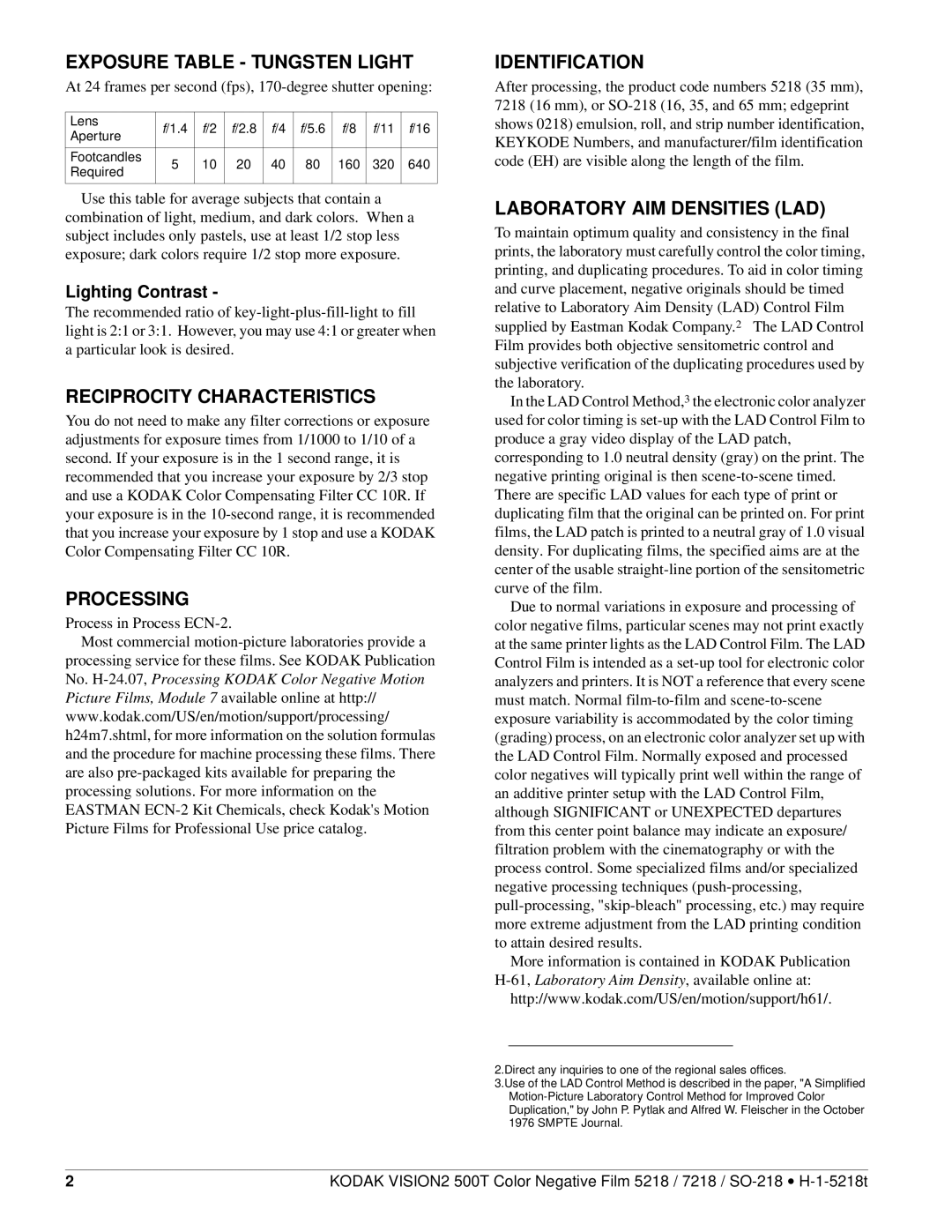EXPOSURE TABLE - TUNGSTEN LIGHT
At 24 frames per second (fps), 170-degree shutter opening:
| Lens | f/1.4 | f/2 | f/2.8 | f/4 | f/5.6 | f/8 | f/11 | f/16 |
| Aperture |
| | | | | | | | |
| | | | | | | | | |
| Footcandles | 5 | 10 | 20 | 40 | 80 | 160 | 320 | 640 |
| Required |
| | | | | | | | |
| | | | | | | | | |
Use this table for average subjects that contain a combination of light, medium, and dark colors. When a subject includes only pastels, use at least 1/2 stop less exposure; dark colors require 1/2 stop more exposure.
Lighting Contrast -
The recommended ratio of key-light-plus-fill-light to fill light is 2:1 or 3:1. However, you may use 4:1 or greater when a particular look is desired.
RECIPROCITY CHARACTERISTICS
You do not need to make any filter corrections or exposure adjustments for exposure times from 1/1000 to 1/10 of a second. If your exposure is in the 1 second range, it is recommended that you increase your exposure by 2/3 stop and use a KODAK Color Compensating Filter CC 10R. If your exposure is in the 10-second range, it is recommended that you increase your exposure by 1 stop and use a KODAK Color Compensating Filter CC 10R.
PROCESSING
Process in Process ECN-2.
Most commercial motion-picture laboratories provide a processing service for these films. See KODAK Publication No. H-24.07, Processing KODAK Color Negative Motion Picture Films, Module 7 available online at http:// www.kodak.com/US/en/motion/support/processing/ h24m7.shtml, for more information on the solution formulas and the procedure for machine processing these films. There are also pre-packaged kits available for preparing the processing solutions. For more information on the EASTMAN ECN-2 Kit Chemicals, check Kodak's Motion Picture Films for Professional Use price catalog.
IDENTIFICATION
After processing, the product code numbers 5218 (35 mm), 7218 (16 mm), or SO-218 (16, 35, and 65 mm; edgeprint shows 0218) emulsion, roll, and strip number identification, KEYKODE Numbers, and manufacturer/film identification code (EH) are visible along the length of the film.
LABORATORY AIM DENSITIES (LAD)
To maintain optimum quality and consistency in the final prints, the laboratory must carefully control the color timing, printing, and duplicating procedures. To aid in color timing and curve placement, negative originals should be timed relative to Laboratory Aim Density (LAD) Control Film supplied by Eastman Kodak Company.2 The LAD Control Film provides both objective sensitometric control and subjective verification of the duplicating procedures used by the laboratory.
In the LAD Control Method,3 the electronic color analyzer used for color timing is set-up with the LAD Control Film to produce a gray video display of the LAD patch, corresponding to 1.0 neutral density (gray) on the print. The negative printing original is then scene-to-scene timed. There are specific LAD values for each type of print or duplicating film that the original can be printed on. For print films, the LAD patch is printed to a neutral gray of 1.0 visual density. For duplicating films, the specified aims are at the center of the usable straight-line portion of the sensitometric curve of the film.
Due to normal variations in exposure and processing of color negative films, particular scenes may not print exactly at the same printer lights as the LAD Control Film. The LAD Control Film is intended as a set-up tool for electronic color analyzers and printers. It is NOT a reference that every scene must match. Normal film-to-film and scene-to-scene exposure variability is accommodated by the color timing (grading) process, on an electronic color analyzer set up with the LAD Control Film. Normally exposed and processed color negatives will typically print well within the range of an additive printer setup with the LAD Control Film, although SIGNIFICANT or UNEXPECTED departures from this center point balance may indicate an exposure/ filtration problem with the cinematography or with the process control. Some specialized films and/or specialized negative processing techniques (push-processing, pull-processing, "skip-bleach" processing, etc.) may require more extreme adjustment from the LAD printing condition to attain desired results.
More information is contained in KODAK Publication H-61, Laboratory Aim Density, available online at:
http://www.kodak.com/US/en/motion/support/h61/.
2.Direct any inquiries to one of the regional sales offices.
3.Use of the LAD Control Method is described in the paper, "A Simplified Motion-Picture Laboratory Control Method for Improved Color Duplication," by John P. Pytlak and Alfred W. Fleischer in the October 1976 SMPTE Journal.
